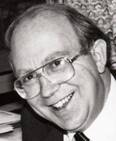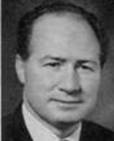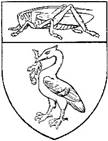|



 Apart from London and the Northern Counties of England, Kent
is unusual in playing host to a large number of Martins Bank’s branches –
twenty-five in all. The Bank’s expansion Southwards starts with the aim of
putting at least one branch in each county, but some cities such as Bristol
and Southampton have several branches. Apart from London and the Northern Counties of England, Kent
is unusual in playing host to a large number of Martins Bank’s branches –
twenty-five in all. The Bank’s expansion Southwards starts with the aim of
putting at least one branch in each county, but some cities such as Bristol
and Southampton have several branches.
|

In Service: December 1961 to 30 May 1986

Images © Barclays Ref
0030-0536 unless otherwise stated

|
|
Although the Bank does not
have a dedicated student branch at the University of Kent at Canterbury, a
leaflet is produced for the students, explaining the services on offer at
Canterbury Branch. Leaflets are produced by the Bank for most of the
universities in England, and each one pinpoints either a student branch on
campus, or nearby Martins Branches that will understand and help students
with their finances.

The spread of branches across
the north-western part of Kent and into the Kentish London suburbs is fairly
even. The new branch at Canterbury is thought of as a kind of showpiece,
being one of the ubiquitous concrete 1960s replacements for traditional
buildings that had been damaged in the Second World War.
|
 
Images © Martins Bank
Archive Collections

|
|

Many of the Branch images on
this page have been featured at one time or another in various issues of
Martins Bank Magazine and in publicity leaflets. We are also fortunate to have two colour
images of the interior of the branch, along with a good number of staff
images. The article below is from the magazine’s main visit to Canterbury
branch in 1963…

  There is a kindliness about
Kent which enables the county to absorb unobtrusively the suburban sprawl and
the unsightly factory. On any journey a copse or a hill will quickly obscure
the more deplorable sights and these glimpses serve as reminders that progress
cannot be halted but could be undertaken with a little more consideration. We last saw Canterbury nearly twenty years ago when we
came to know that part of the country well. Our tanks tore up her rich
farmland and gouged her lanes, our lorries broke down her gateposts and we
built gun sites and nissen huts in her orchards. Though the wounds have
healed Kent saw no reason to show us more than this to-day. Over the rest she
drew a misty veil and, for spring, her welcome was chilly. Who shall say she was
wrong ? German bombs destroyed much of
Canterbury and when we reached the High Street, we sought direction from a
policeman. “Martins Bank? Yes, in Rose Lane there on your right. It's a new, queer looking place. All lumps
of cement”. Well it is new,
modern and contemporary. There is a kindliness about
Kent which enables the county to absorb unobtrusively the suburban sprawl and
the unsightly factory. On any journey a copse or a hill will quickly obscure
the more deplorable sights and these glimpses serve as reminders that progress
cannot be halted but could be undertaken with a little more consideration. We last saw Canterbury nearly twenty years ago when we
came to know that part of the country well. Our tanks tore up her rich
farmland and gouged her lanes, our lorries broke down her gateposts and we
built gun sites and nissen huts in her orchards. Though the wounds have
healed Kent saw no reason to show us more than this to-day. Over the rest she
drew a misty veil and, for spring, her welcome was chilly. Who shall say she was
wrong ? German bombs destroyed much of
Canterbury and when we reached the High Street, we sought direction from a
policeman. “Martins Bank? Yes, in Rose Lane there on your right. It's a new, queer looking place. All lumps
of cement”. Well it is new,
modern and contemporary.
 It
is in keeping with the new development which will provide a City Centre and
is already well under way. Canterbury to-day is Contrast and since our visit
we have been thinking about this. Should the planners have attempted to rebuild
'as it was'? The policeman clearly
thought so and most of us tend to be conservative in these matters. Could the
old narrow streets have survived much longer? And were the dark and damp old
buildings attractive only to look at? Perhaps the survival of Dane John
Place, Pin Hill, Mercery Lane and Beer Cart Lane is sufficient reassurance
that Canterbury is still very much a part of timeless Kent.
In many respects the branch resembles
that at Holloway Circus, Birmingham, and we were amused to find that Mr. Farrell and his staff have introduced a
signal system for customers arriving late and peering dejectedly or hopefully
through the glass front. This signal resembles a wide right (or left) hook,
in slow motion, finishing with the hand pointing in the direction of the back
door: as one side of the office is clear, the detour can be effected quite
quickly. This signal would not do for Holloway Circus where we are built up
on each side and where the customer, having eventually found the back door,
might discover that the staff had gone home in the meantime. We have been
told at both branches that the open front is sometimes an embarrassment and
moreover no cashier likes to stack large quantities of cash on the counter in
full view of the more prying members of the public. Possibly some form of
sunblind would provide a solution but, having said that, the office otherwise
is exceptionally spacious, comfortable and well fitted. The Canterbury staff make a happy quartet
and, if they have a worry, it is how to get through a day's work in
reasonable time when both the manager and his deputy are often engaged with
separate interviews at the same time, leaving one man for the counter and a
lady to try and do everything else. It is one of the problems peculiar to an
active, newly opened branch. Mr. E. M. Farrell has settled quickly into his
new surroundings and is so obviously enthusiastic and happy that he makes
light of his problems. We were fortunate to have Mrs. Farrell with us for
lunch and afterwards made a quick tour of some of the surrounding country.
Mr. Farrell entered the Bank in 1943 at Cocks Biddulph and apart from two
years with H.M. Forces and a period as cashier on the S.S. Halladale has
spent all his time at London branches. He attended the Domestic Training
Scheme in 1957 and was appointed Manager at Canterbury when it opened in
December 1961. It
is in keeping with the new development which will provide a City Centre and
is already well under way. Canterbury to-day is Contrast and since our visit
we have been thinking about this. Should the planners have attempted to rebuild
'as it was'? The policeman clearly
thought so and most of us tend to be conservative in these matters. Could the
old narrow streets have survived much longer? And were the dark and damp old
buildings attractive only to look at? Perhaps the survival of Dane John
Place, Pin Hill, Mercery Lane and Beer Cart Lane is sufficient reassurance
that Canterbury is still very much a part of timeless Kent.
In many respects the branch resembles
that at Holloway Circus, Birmingham, and we were amused to find that Mr. Farrell and his staff have introduced a
signal system for customers arriving late and peering dejectedly or hopefully
through the glass front. This signal resembles a wide right (or left) hook,
in slow motion, finishing with the hand pointing in the direction of the back
door: as one side of the office is clear, the detour can be effected quite
quickly. This signal would not do for Holloway Circus where we are built up
on each side and where the customer, having eventually found the back door,
might discover that the staff had gone home in the meantime. We have been
told at both branches that the open front is sometimes an embarrassment and
moreover no cashier likes to stack large quantities of cash on the counter in
full view of the more prying members of the public. Possibly some form of
sunblind would provide a solution but, having said that, the office otherwise
is exceptionally spacious, comfortable and well fitted. The Canterbury staff make a happy quartet
and, if they have a worry, it is how to get through a day's work in
reasonable time when both the manager and his deputy are often engaged with
separate interviews at the same time, leaving one man for the counter and a
lady to try and do everything else. It is one of the problems peculiar to an
active, newly opened branch. Mr. E. M. Farrell has settled quickly into his
new surroundings and is so obviously enthusiastic and happy that he makes
light of his problems. We were fortunate to have Mrs. Farrell with us for
lunch and afterwards made a quick tour of some of the surrounding country.
Mr. Farrell entered the Bank in 1943 at Cocks Biddulph and apart from two
years with H.M. Forces and a period as cashier on the S.S. Halladale has
spent all his time at London branches. He attended the Domestic Training
Scheme in 1957 and was appointed Manager at Canterbury when it opened in
December 1961.


Images – Martins Bank
Archive Collections



In Mr. J. S. Ford it seemed to us that
Mr. Farrell has a duplicate manager in whom keenness and a sense of humour
predominate. The provision of an interview room in the office has enabled him
to take much off his Manager's shoulders and his enjoyment of responsibility
was manifest. His lunch hour was hopelessly curtailed but, far more important
to him, he had opened a new account. He joined the Bank at Orpington in 1946,
subsequently working at a number of London branches and attending the
Domestic Training Scheme in 1956. He was with H.M. Forces from 1947 to 1949.
The third male member of the staff, Mr.
J. G. Wylie, started in the Bank at Liverpool in 1959 from H.M. Forces, moved to Derby after two weeks and
then to a number of Midland District branches before going to London in
December 1961 and on to Canterbury when it opened. He lives at Herne Bay,
plays lots of golf and is currently doing his best to get the better of Part
I with which his frequent moves have interfered.
Miss Denise Plummer is another of those
happy local discoveries, interested and quick in the uptake. In this new
branch where public relations are of first importance we look forward to the
day when Miss Plummer can be spared for counter duties. Despite the enjoyment of the day it was necessary to
leave the staff to complete their work so we took another long look at the
branch from outside and, whatever the policeman may have felt, we liked it.
There is a sense of purpose about it and it was this which brought to us the
realisation that Canterbury, in common with so many of our fine old cities,
makes one want to spend time—even to waste it. In Canterbury branch they use it!

|
 At Canterbury, this feature is not so much “Then
and Now” as “Then and a little bit
later”, as we are comparing the
branch Branch with its 1977 incarnation as Barclays Rose Lane. Whilst much internal aesthetic damage has
been done by the addition of counter screens, (largely out of necessity
following the trend for armed raids), it is heartening to find the
Grasshopper of the South still taking pride of place on the back wall of the
Banking Hall… At Canterbury, this feature is not so much “Then
and Now” as “Then and a little bit
later”, as we are comparing the
branch Branch with its 1977 incarnation as Barclays Rose Lane. Whilst much internal aesthetic damage has
been done by the addition of counter screens, (largely out of necessity
following the trend for armed raids), it is heartening to find the
Grasshopper of the South still taking pride of place on the back wall of the
Banking Hall…

|
|
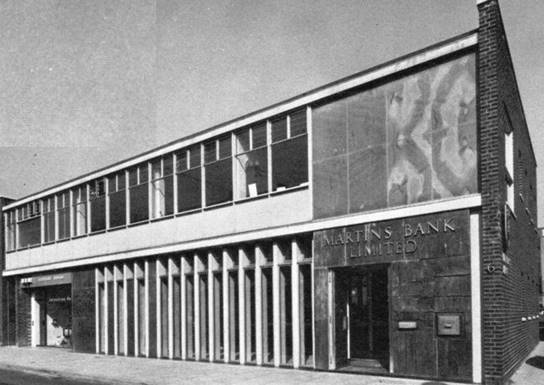
Image –
Martins Bank Archive Collections

|
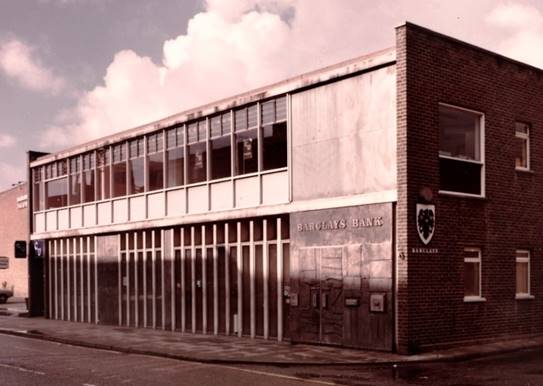
Image –
Martins Bank Archive Collections

|
|
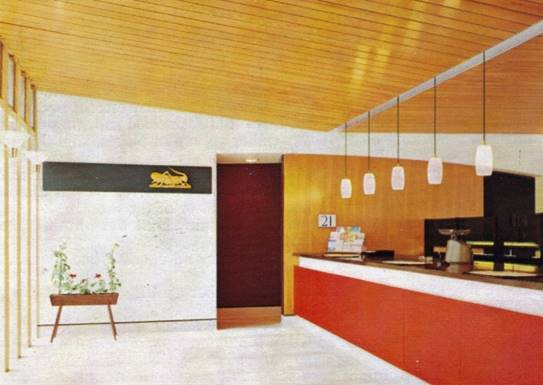
Image –
Martins Bank Archive Collections
|
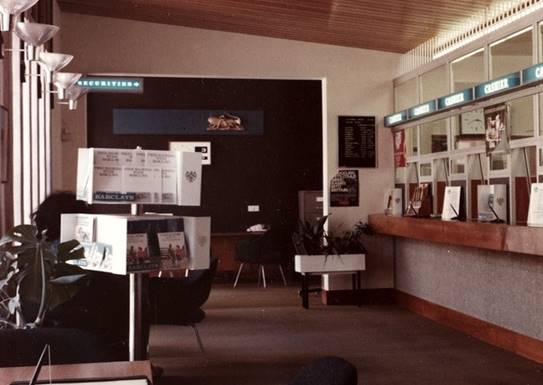
Image ©
Barclays Ref 0030-0536
|

|



















